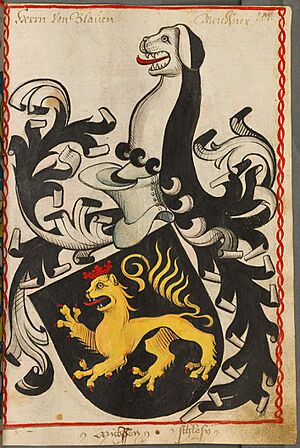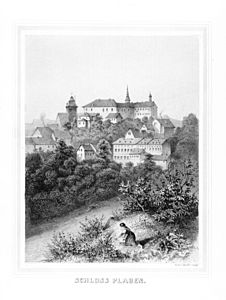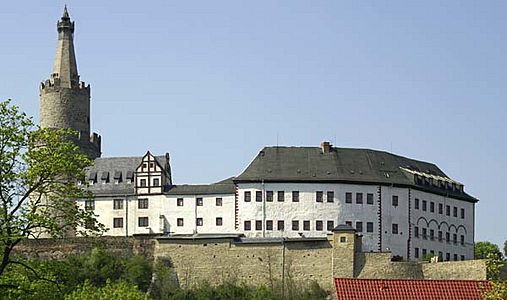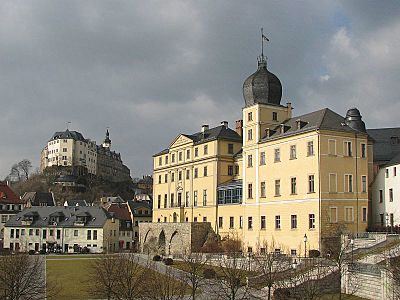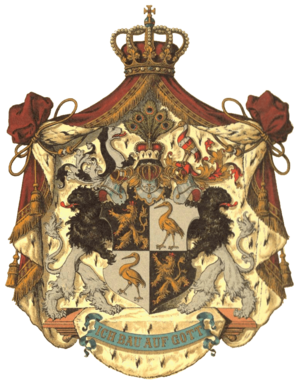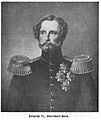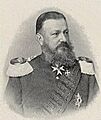Imperial County of Reuss facts for kids
Quick facts for kids
Imperial County of Reuss
Reichsgrafschaft Reuß
|
|||||||||||
|---|---|---|---|---|---|---|---|---|---|---|---|
| c. 1010–1778/1806 | |||||||||||
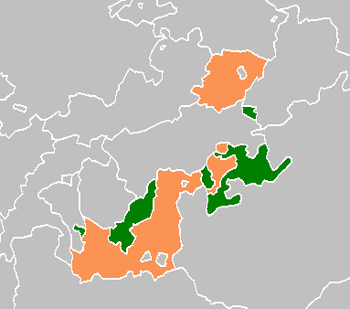
Reuss in 1820: Elder (green) and Younger (orange) line
|
|||||||||||
| Status | County | ||||||||||
| Capital | Weida until 1531, then Plauen, Gera and Greiz | ||||||||||
| Government | Principality | ||||||||||
| Historical era | Middle Ages | ||||||||||
|
• Established
|
c. 1010 | ||||||||||
| c. 1206 |
|||||||||||
|
• Partitioned into Elder,
Middle and Younger line |
1564 |
||||||||||
|
• Principality of Reuss
Elder Line |
1778 |
||||||||||
|
• Principality of Reuss
Junior Line |
1806 | ||||||||||
|
|||||||||||
Reuss (German: Reuß [ʁɔɪ̯s], royss) was the name for several historical states in what is now Thuringia, Germany. These states were ruled by the House of Reuss. They started as small lordships around 1300. Later, they became Imperial Counties in 1673 and then Imperial Principalities in the late 1700s.
These counties often split into smaller parts. Sometimes they merged back together, only to divide again. After the Holy Roman Empire ended in 1806, some Reuss states joined the German Confederation. The smaller ones eventually merged into one principality by 1848.
By 1871, two main Reuss territories remained. They became part of the German Empire. These were the Principality of Reuss Elder Line (capital: Greiz) and the Principality of Reuss Younger Line (capital: Gera). The House of Reuss ruled both until the German Revolution of 1918–1919. The head of each family branch was called Fürst (Prince). Other family members were called Prinz or Prinzessin (Prince/Princess).
Since the late 1100s, all male members of the House of Reuss have been named Heinrich (Henry). This honored Henry VI, Holy Roman Emperor (1190–1197). The family owed him the lands of Weida and Gera. To tell them apart, they used numbers and nicknames.
Contents
History of the Reuss States
Many different Reuss principalities existed over time. By the time the German Confederation was formed, only two main lines remained. These were the Elder and the Younger lines. Before that, they were part of the Holy Roman Empire and then the Confederation of the Rhine.
How Reuss Began
Long ago, Slavic people lived in the Reuss region. Emperor Otto I (936–973) helped convert them to Christianity. The church in this area was led by the Diocese of Zeitz. Later, the bishop moved to Naumburg, and the area became known as Naumburg-Zeitz.
The German Emperor Otto III allowed German settlers to clear forests and farm in eastern Thuringia around the year 1000. Emperor Henry IV appointed Henry the Pious of Gleissberg (c. 1040−1120) as the imperial bailiff (vogt). This meant he managed the land for the emperor. The area he controlled was called Vogtland, meaning "Land of the Bailiff." This name is still used today for a region in Saxony, Thuringia, and northern Bavaria.
The Bailiffs' Family (Vogts)
The job of vogt soon became something passed down in families. Henry the Pious's lands included Gera and Weida. His grandson, Henry II the Rich, also gained Plauen. When Henry II's three sons divided their inheritance, three separate areas were formed. These were ruled by the bailiffs of Weida-Ronneburg, Plauen-Gera, and Greiz-Reichenbach.
The bailiffs started as unfree nobles. But they quickly became powerful lords. They kept the title Vogt as a family title. By 1329, Emperor Ludwig the Bavarian said the bailiffs had a rank similar to Princes of the Holy Roman Empire. However, they still used the name Vogt.
Over time, the bailiffs of Weida became independent. Their lands grew to include what is now called Vogtland. They even controlled areas that reached into what is now the Czech Republic.
The Weida family branch died out in 1535. The Greiz-Reichenbach branch was inherited by the Plauen-Gera branch. This branch then split into Plauen (elder and younger lines) and Gera-Schleiz-Lobenstein. The elder Plauen line died out in 1380. The younger Plauen line was started by Henry (died around 1300). He was called "der Reusse" (meaning "the Russian"). This was because he had spent time in Eastern Europe and married a granddaughter of King Daniel of Galicia. This nickname later became the name of his country and family: Reuss.
The House of Reuss came from the bailiffs of Plauen. They inherited cities and lordships like Gera, Greiz, Schleiz, and Lobenstein. However, in the 1300s and 1400s, the bailiffs lost most of their lands. Much of it went to the Electorate of Saxony, including Weida in 1427 and Plauen in 1482.
-
Plauen city and castle (1859)
The House of Reuss Today
In 1306, the Plauen branch of the bailiffs split into an elder line (at Plauen) and a younger line (at Greiz and Reichenbach), called Reuss. In 1564, this younger line split into three more branches: the Elder (which ended in 1927), the Middle (ended in 1616), and the Younger (whose ruling line ended in 1945).
A side branch, Reuss-Köstritz, started in 1692. Its members became non-ruling princes in 1806. This branch is the only part of the family that still exists today. It has about 30 male members, all named Heinrich. The oldest male in this branch is now the head of the entire House of Reuss.
In 1673, the Reuss lords became Imperial Counts. From 1778, they became Imperial Princes. The family ruled many different areas. Around 1700, there were ten Reuss counties. The rulers were always called "Count Reuss" or "Prince Reuss," not "of Reuss." This is because Reuss was a personal name, not a place name. It came from the founder's connection to "Reussen" (an old German word for "Russians").
The Reuss rulers quickly adopted Lutheranism. They even fought against the German emperor in the Schmalkaldic League. They lost their lands for a short time but got them back.
The Heinrichs: A Unique Naming Tradition
All male members of the House of Reuss are named Heinrich (Henry) plus a number. This tradition started around 1200. It was a way to honor Henry VI, Holy Roman Emperor. He had given Henry the Rich (+1209) the important job of bailiff.
The numbering system is a bit unusual:
- In the elder line, numbers go up to 100, then start again at 1. This includes all male children, even those who were stillborn.
- In the younger line, numbers go up until the end of the century. Then they start again at 1 for the first child born in the new century. This also includes all male children.
This special rule was made official in 1688.
Major Divisions of Reuss
In 1564, the sons of Henry XIII of Reuss at Greiz divided their lands into:
- Reuss at Lower Greiz (descendants of Henry XIV the Elder)
- Reuss at Upper Greiz (descendants of Henry XV the Middle)
- Reuss at Gera (descendants of Henry XVI the Younger)
The Middle Reuss line ended in 1616. The Elder and Younger lines divided many more times. In 1778, Count Henry XI united the lands of Upper and Lower Greiz. This formed the Principality of Reuss Elder Line. The remaining lands of Gera became the Principality of Reuss Younger Line in 1806.
Both Reuss principalities joined the German Confederation in 1815. Several parts of the Younger Line merged into one state by 1848.
Henry XXII of Reuss Elder line was known for not liking Prussia. He opposed them in the Austro-Prussian War of 1866. Prussian troops even took over his land. Henry joined the North German Confederation and the new German Empire in 1871. He remained an opponent of Prince Bismarck and the new German Empire until his death in 1902.
Despite his views, his daughter Hermine Reuss of Greiz later married the exiled German Emperor Wilhelm II. Other daughters of the family also made important marriages. For example, Countess Augusta Reuss of Ebersdorf was the grandmother of Queen Victoria. Princess Augusta Reuss of Köstritz married the Grand Duke of Mecklenburg-Schwerin in 1849. Eleonore Reuss of Köstritz became queen of Bulgaria in 1908.
Heinrich XXIV, Prince Reuss of Greiz (1878–1927) could not rule. So, the prince of the younger line of Reuss took over as regent. Since Henry XXIV had no children, it was expected that the elder line's principality would join the younger line after his death. This would create a united Reuss state.
However, both lines lost their thrones in the German Revolution of 1918–19. A united, but republican, state called the People's State of Reuss was formed in 1919. It later merged with the larger state of Thuringia in 1920. The united state of Reuss covered about 1,143 square kilometers and had 211,324 people in 1919.
A non-governing side branch of the younger line started in 1692. This was when Heinrich XXIV, Count Reuss of Köstritz, a younger son, received some lands. His main home was Köstritz Castle. This branch connected with important ruling families through marriages. They did not rule their own territory but lived as landowners. Henry XLIII, Count Reuss of Köstritz, was made a hereditary prince by Emperor Francis II in 1806.
The elder line ended with Henry XXIV in 1927. The younger ruling line ended when Henry XLV died childless in 1945. So, the right to the family titles passed to the princely House Reuss of Köstritz. This side line is the only part of the family that still exists today. It has over 30 male members, all named Heinrich. In 1930, the family decided that all members should just call themselves "Prince" or "Princess Reuss." This name was kept even in the Weimar republic.
The current head of the family is Heinrich XIV (born 1952). He is called "The Fürst (Prince) Reuss." His main home is Ernstbrunn Castle in Austria. His family inherited it in 1822. Köstritz Castle was taken by communist East Germany in 1945 and torn down in the 1970s. In 1945, the Reuss Princes lost all their lands and castles in their homeland. After German Reunification in 1990, Heinrich XIV and some relatives got back some properties in the former Reuss states.
What Happened After World War I?
After World War I, the Reuss territories joined together in 1919. They became the People's State of Reuss. In 1920, this state became part of the new state of Thuringia.
-
Orangery at Gera
In Fiction
A young Reuss count is a main character in the 1899 operetta Wiener Blut. He is sent to the 1815 Congress of Vienna. The 1942 film based on the operetta also features him. Much of the humor in the film comes from his long and unusual name: "Reuss-Schleiz-Greiz."
See Also
- Burgraves of Meissen
Images for kids



